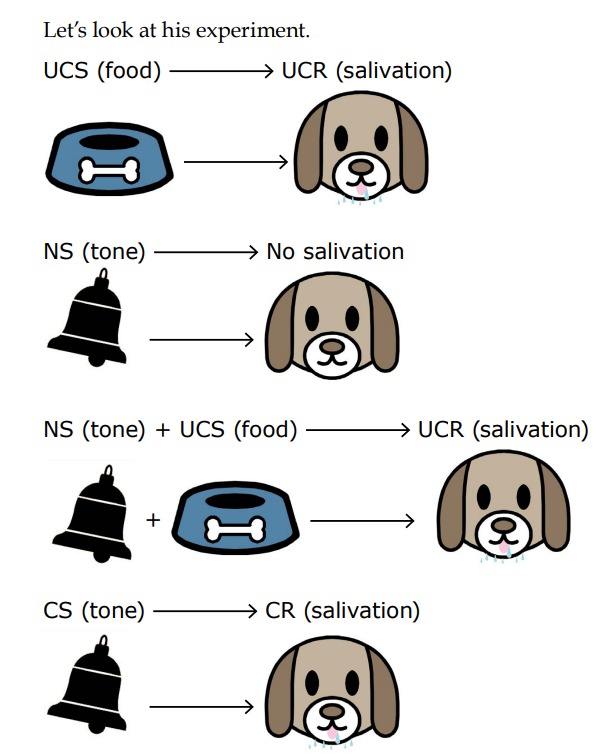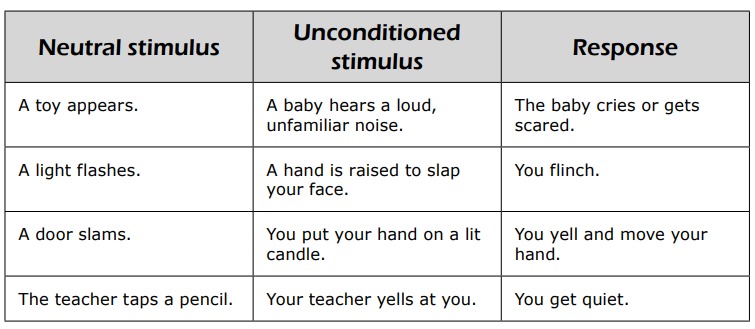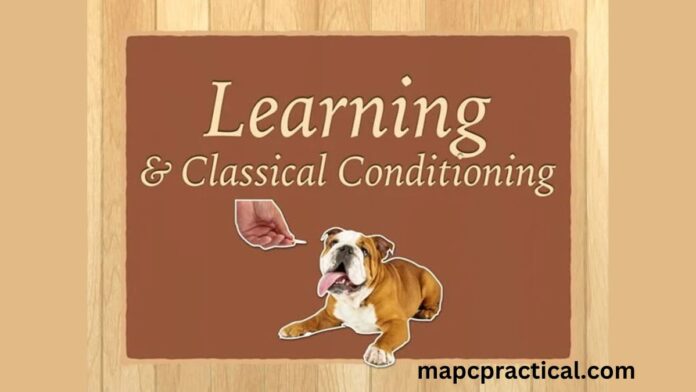Classical conditioning is a form of learning by an association between two stimuli. A stimulus is anything in the environment to which one can respond.
For instance, if you are in the shower and someone flushes the toilet, you know what might happen. The cold water goes to the toilet and the shower temperature momentarily turns hot enough to scald. You jump aside to get out of the hot water.
Let’s say that every time someone flushes when you are in the shower they yell the word “flush” before the hot water hits you. You would naturally jump aside so that you wouldn’t get scalded. If this happened repeatedly, you would jump aside every time you heard the word “flush”. Hence, you would be classically conditioned.
Components of Classical Conditioning
Classical conditioning is a type of learning in which an organism learns to associate two previously unrelated stimuli. The components of classical conditioning are:

- Unconditioned Stimulus (UCS): This is a stimulus that naturally and automatically triggers a response, such as food causing salivation.
- Unconditioned Response (UCR): This is the natural and automatic response to the UCS, such as salivating when presented with food.
- Conditioned Stimulus (CS): This is a previously neutral stimulus that is repeatedly paired with the UCS, such as a bell ringing before food is presented.
- Conditioned Response (CR): This is the learned response to the CS, such as salivating at the sound of a bell after it has been repeatedly paired with food.
The idea of classical conditioning came from Ivan Pavlov and his experiments with salivating dogs.

Ivan Pavlov’s Discovery
Ivan Pavlov was a Russian medical doctor. He noticed that when he put food in a dog’s mouth, the dog began to salivate. And Pavlov also noticed that the dog began salivating at the sight of the food. He designed experiments to investigate what would happen if he paired a neutral stimulus (a light, a buzzer, a touch on the leg) with an unconditioned stimulus (food). After repeated pairings, the neutral stimulus alone produced salivation.

Classical Conditioning Processes
Pavlov identified five major conditioning processes:
- acquisition
- extinction
- spontaneous recovery
- generalization
- discrimination
Acquisition
The acquisition is the process of learning a conditioned response to an unconditioned stimulus. This can be done through the repeated pairing of the two stimuli.
The first stage of classical conditioning is called acquisition. It occurs when a neutral stimulus (NS) is paired with an unconditioned stimulus (UCS). Every time the two are paired, it is called a trial.
In our example with the shower, we would pair the word “flush” (NS) with the hot water (UCS). When you jump aside upon merely hearing the word, then acquisition or learning has occurred. The conditioned response (CR) will be maintained only if the word “flush” continues to be paired with the hot water on some trials.
UCS (hot water) ——->UCR (jump aside)
NS (word) + UCS (hot water) ——-> CR (jump aside)
CS (word) ——-> CR (jump aside)
What happens when the CS occurs repeatedly without a UCS? That is when the word “flush” is not followed by hot water or, in Pavlov’s experiment, the tone is not followed by food. The process of extinction occurs.
Extinction and Spontaneous Recovery
Extinction occurs when a conditioned stimulus (CS) no longer produces or elicits a conditioned response (CR). The word “flush” doesn’t cause you to jump aside in the shower and the dogs don’t salivate when they hear a tone. It is important to note that after a rest period, a CR can reappear. This is called spontaneous recovery. The CR reappears even though it is weaker.
Generalization and Discrimination
Pavlov noticed that a dog that is conditioned to one tone will also respond to similar-sounding tones. He called this process generalization. It is the tendency to respond to stimuli that are similar to the CS.
Pavlov’s dogs also learned to respond to the sound of a particular tone and not others. He called this process discrimination. It is the learned ability to distinguish between different stimuli.
Classical Conditioning in Everyday Life
Many responses in our everyday life can be and have been classically conditioned. Let’s look at four examples. If you repeatedly pair the UCS and the NS, then the NS will become the CS and, all by itself, will give you the response.

Eventually, the neutral stimulus, which is now the conditioned stimulus, will give you the response.
Emotions can also be classically conditioned. John Watson, an American psychologist, demonstrated that fears could be explained by the principles of classical conditioning.
He did this by intentionally establishing a fear of rats in an eleven-month-old boy named Albert. They paired a white rat (NS) with a loud noise (UCS). Eventually, the sight of the rat alone produced fear. J.B. Watson was able to demonstrate generalization because Albert feared furry white toys. He was also able to demonstrate discrimination because Albert didn’t fear all toys. This experiment could never be conducted today because of the ethical guidelines that are set by the American Psychological
Association.

Taste aversion can also be classically conditioned. The research of John Garcia and Robert Koelling showed how avoidance of certain tastes could develop through classical conditioning. On experiments with rats, they discovered that it was possible to use a nausea-producing drug or radiation as a UCS. By pairing that with any food, in time, the food alone produced the feeling of nausea.
Role of Cognition and Biology
Cognitive processes and biology are both involved in classical conditioning.
It was once believed that conditioning was the same in all animals. This meant that you could study human behaviour by studying any animal and that you could associate any neutral stimulus with a response. This is, however, not true. Animals have biological predispositions to associating certain stimuli over others.
For example, you eat a new food and later get sick. You will be conditioned to associate the taste of the food with getting sick (and thus avoid that food in the future). You don’t avoid the type of music that was playing in the restaurant, the type of plate it was served on, or the perfume that your neighbour was wearing.
REAL-WORLD APPLICATION OF CLASSICAL CONDITIONING
Classical conditioning is a process of learning in which a conditioned stimulus is paired with an unconditioned stimulus.
1. Conditioning people to act according to your will:
A classical conditioning experiment was conducted by John Watson and Rosalie Rayner, who wanted to condition a nine-month-old infant known as Little Albert to fear a white rat. In the experiment, Albert was exposed to the rat at the same time as a loud noise (the unconditioned stimulus). After several pairings of these two stimuli, Little Albert would cry whenever he saw the rat (the conditioned response).
2. Conditioning people not to do something:
An example of this type of conditioning is when people are conditioned not to fear snakes by being shown pictures of snakes with no negative consequences after seeing them. This type of conditioning can also be seen in phobias where people are conditioned not to fear things like spiders or heights through gradual exposure and desensitization therapy.
Applications of Classical Conditioning in the classroom
This technique can be used in many ways, such as teaching students how to read words through associating them with pictures or teaching kids how to stay away from drugs by associating them with unpleasant feelings like nausea or pain.
Classical conditioning can be used in the classroom to teach students about how their brain works and how it processes information.
Classical Conditioning has been used in the classroom for decades. In fact, it’s been used since the time of Pavlov. Pavlov was able to make dogs salivate at the sound of a bell by ringing it before feeding them. The dog would come to associate the sound of the bell with food and would begin to salivate whenever they heard it.
Similarly, teachers can use classical conditioning to teach kids about various subjects by associating a certain stimuli with another one (i.e., math problems are associated with solving equations). This technique can also be used for more complex concepts such as empathy and understanding other people’s perspectives.
Criticisms of Classical Conditioning
Classical conditioning is a type of learning in which a learned association is formed between two stimuli.
The most common criticism of classical conditioning is that it does not account for the complexity of human behavior. Classical Conditioning does not take into account the degree to which behaviors are shaped by previous experience, or the degree to which they are shaped by individual variation.
Lesson Summary
Learning is any relatively permanent change in behaviour or thinking that is due to experience. Classical conditioning is one type of learning by association. In this lesson, the components of classical conditioning were explained. They include the following:
- unconditioned stimulus
- unconditioned response
- neutral stimulus
- conditioned stimulus
- conditioned response
The processes of classical conditioning were also explained. These include the following:
- acquisition
- extinction
- spontaneous recovery
- generalization
- discrimination
The research of Pavlov, Watson and Garcia and Koelling was explained to illustrate classical conditioning




